
NPS photo 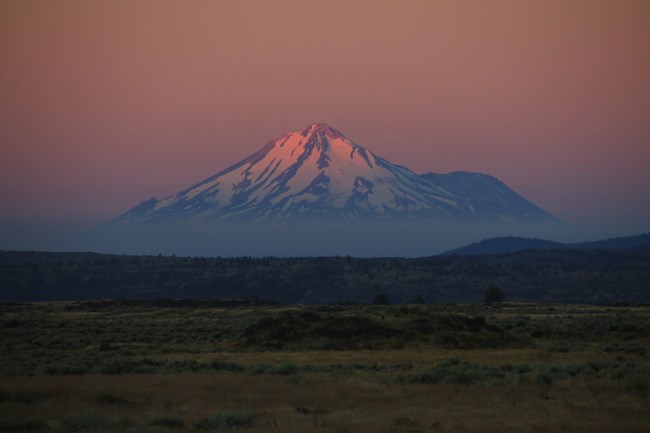
photo by N. Charlton Where did the lava come from?Driving into Lava Beds National Monument, few people realize that they are traveling up the side of a massive volcano. The monument is located on the Medicine Lake shield volcano, which is the largest volcano by volume in the Cascade Range at 144 cubic miles. Shield volcanoes are broad, gently sloping mountains that form from many dispersed, low energy eruptions of very fluid molten rock. These liquid rock flows are able to travel great distances before hardening, and result in a large, low-profile volcano. This is in contrast to the tall, pointed composite cones (or stratovolcanoes) that form from eruptions of relatively thick, cool lavas exploding or oozing from a central collection of vents. This viscous lava travels only a short distance before hardening into a steep cone, much like Mount Shasta.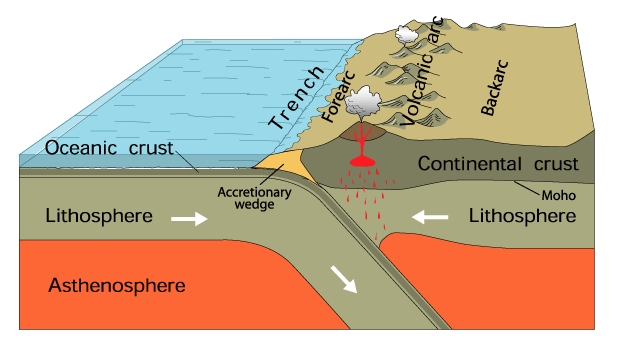
USGS Image Medicine Lake Shield VolcanoThe Medicine Lake shield volcano, and in fact the entire Cascade Range, is the result of tectonic plate movement. The crust of the Earth is broken up into plates that move slowly around the Earth’s surface driven by heat energy deep in the Earth’s interior. In places where the plates collide, one plate will often slide under the other in a process known as “subduction.” The Medicine Lake Volcano is the result of the Juan de Fuca Plate sliding under the North American Plate. As it dives deep into the Earth it drags water underground. The water lowers the melting point of the mantle, allowing it to melt into magma, which then rises to the surface as lava. View this Geologic Map of Medicine Lake to better understand this unique volcano.
The Medicine Lake Volcano has erupted intermittently for the past halfmillion years, but most of the lava in the monument erupted thirty to forty thousand years ago from Mammoth and Modoc Craters. The most recent flows from the Medicine Lake Volcano can be found at Glass Mountain (south of Lava Beds in the Modoc National Forest) which erupted about 950 years ago. The most recent lava flow in the monument is the Callahan flow, which erupted 1,200 years ago. Since these last eruptions were relatively recent in geologic terms, Medicine Lake is considered an active volcano. It is currently dormant (not erupting), but seismic activity and continued tectonic movement suggest that it will erupt again in the future. You can read more in this hazards assessment for Medicine Lake Volcano.
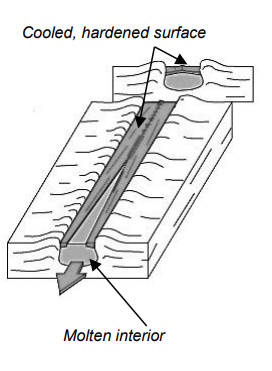
NPS Photo Geologic FeaturesAs you explore Lava Beds, you will find a number of interesting geologic features. Keep your eyes open for the following clues to volcanic and tectonic activity in the area:Lava Tube CavesBasaltic eruptions, like those found in the monument, usually begin with a flood of lava. In areas of lower elevation, such as valleys, the lava moves faster and takes longer to cool, creating a network of lava rivers and tributaries. Eventually, in much the same way that a river of water can freeze over with ice, the surfaces of these lava rivers cool and harden into rock. This rock insulates the lava that continues to flow inside. When the supply of lava stops, the tube drains, leaving behind a hollow cast known as a lava tube.Based on how they form, it may seem as though the monument should have a few very long caves rather than many shorter ones. In some cases, a single lava river forms multiple caves because parts of the lava river never hardened into rock. In other cases, the roof formed, but it was too weak to support itself and collapsed after the lava drained out. Luckily, the collapses in Lava Beds’ caves occurred when the lava first drained thousands of years ago, and the cave roofs are now very stable. 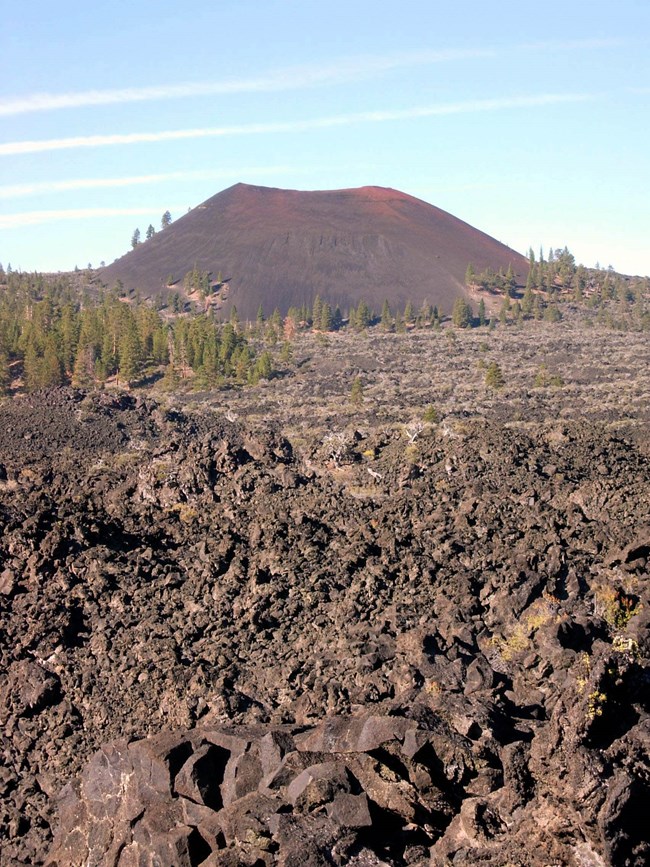
NPS photo Cinder ConesKnown locally as buttes, these rounded hills dot the Lava Beds landscape. They are the result of highly pressurized lava with many dissolved gases that erupt violently, blowing a fountain of molten rock into the air. The lava cools mid-air and falls as rock fragments, creating a mound of cinders that eventually grows to cover the vent. Once most of the gases have been released, fluid lava begins leaking from the vent or from the base of the cinder cone, sometimes dragging the side of the cone with it, stretching and deforming the butte.Due to their loose, rocky nature, these features are highly prone to erosion, and we ask that visitors refrain from hiking on cinder cones without established trails. However, the monument does have one cinder cone, Schonchin Butte, with a 0.7 mile trail to the top. Visitors who make the hike to the fire lookout at the summit will be rewarded with breath-taking views of the surrounding mountains, buttes, and the Tule Lake Basin. 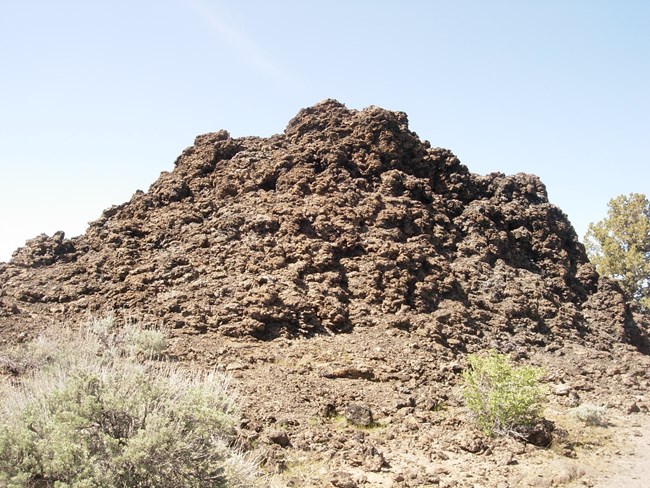
NPS photo Spatter ConesSpatter cones form through a process similar to that of cinder cones, but with some important differences. These eruptions occur on a smaller scale, and the lava that creates them has not cooled much by the time it hits the ground. This semimolten rock behaves like plaster thrown into the air around the central vent. It is thick and sticky, and it builds up into tall, lumpy, chimney-like features.Impressive examples of spatter cones can be found at Black Crater and Fleener Chimneys. While the vent that created Black Crater became fully plugged with lava, making it a shallow spatter cone, the vents at Fleener Chimneys were plugged much further down, leaving deep tubes. Please help us preserve these impressive features by staying on the trail and not throwing rocks or trash into the chimneys! 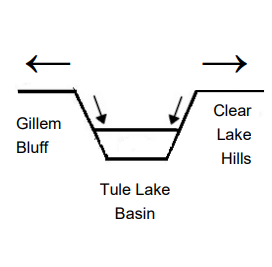
NPS Photo Fault ScarpsLike volcanoes, these steep slopes and cliffs are also the result of tectonic forces. They are created through a process known as extension, which is when a tectonic plate is pulled in two different directions. This causes the plate to break along its weak points and creates a series of parallel cracks, or faults. As the plate continues to pull apart, wedges of land sink down between the faults into the crust. The result is a steep slope along the fault. In Lava Beds, the stretching North American Plate broke the crust along Gillem Bluff to the west and along the Clear Lake Hills to the east of the monument. As the plate continued to stretch and the weight of the volcano grew in size with each eruption, the land between these faults sank to create the Tule Lake Basin. |
Last updated: April 12, 2024
